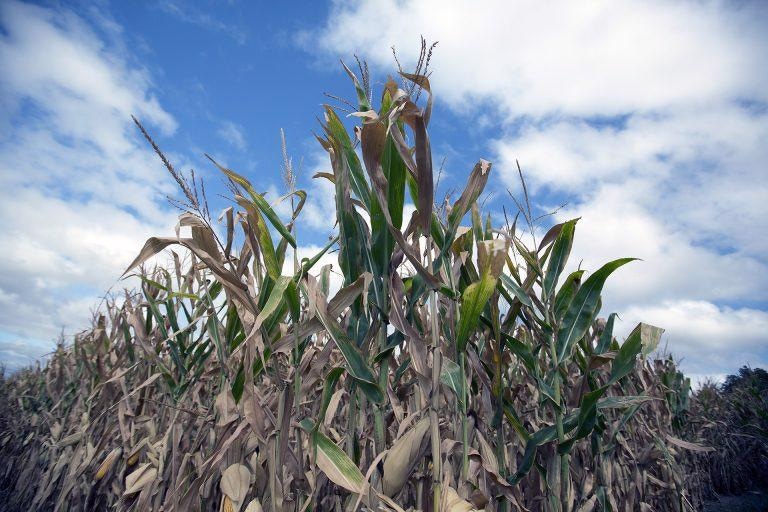Similar to flash floods, flash droughts come on fast — drying out soil just in a matter of days or weeks. Such events can destroy crops and result in huge economic losses. Also, according to researchers, the speed at which they tend to dry out the landscape has considerably increased.
 Dry corn stalks in Iowa during the flash drought of the summer of 2012 wiped out crops and caused $35.7 billion in losses. Image Credit: USDA.
Dry corn stalks in Iowa during the flash drought of the summer of 2012 wiped out crops and caused $35.7 billion in losses. Image Credit: USDA.
Scientists at the University of Texas at Austin, the Hong Kong Polytechnic University, and Texas Tech University have discovered that although various flash droughts have continued to be stable over the past 20 years, the majority of them are coming on faster.
Throughout the world, the flash droughts that come on the quickest — sending areas into drought conditions within just five days — have increased by around 3% to 19%. Also, in places that are particularly prone to flash droughts — like Southeast Asia, South Asia and central North America — the increase is around 22% to 59%.
Perhaps, increasing global temperatures are behind the quicker onset, stated co-author and UT Jackson School Professor Zong-Liang Yang, who added that the study’s outcomes emphasize the significance of comprehending flash droughts and planning for their effects.
Every year, we are seeing record-breaking warming episodes, and that is a good precursor to these flash droughts. The hope and purpose [of this research] is to minimize the detrimental effects.
Zong-Liang Yang, Professor, Jackson School of Geosciences, The University of Texas at Austin
The study has been reported in the Nature Communications journal. It was headed by doctoral student Yamin Qing and Professor Shuo Wang, both of The Hong Kong Polytechnic University.
Flash droughts are comparatively new to science. The progress of remote sensing technology during the past couple of decades helped disclose instances of soil drying out quickly. This acts as the telltale sign of the start of a flash drought and can make drought conditions appear apparently out of the blue.
As the name indicates, flash droughts live only for a short period of time and it generally lasts only for a few weeks or months. However, when they take place at critical growing periods, they can result in disasters.
For instance, in the 2012 summer, a flash drought in the central United States made the corn crop fade, thereby resulting in an estimated $35.7 billion in losses.
In this study, the researchers examined global hydroclimate data sets utilizing satellite soil moisture measurements to capture a global picture of flash drought and how it has altered over the past 21 years.
The data exhibited that nearly 34% to 46% of flash droughts came on in five days. The rest come out within a month, with over 70% developing in half a month or less.
When the researchers analyzed the droughts over time, they observed that flash droughts will take place more rapidly.
Also, the study disclosed the significance of humidity and variable weather patterns, with flash droughts becoming more likely when there is a shift noted from humid to arid conditions.
This makes regions that experience seasonal swings in humidity — like Southeast Asia, the Amazon Basin, the East Coast and the Gulf Coast of the United States — flash drought hot spots.
We should pay close attention to the vulnerable regions with a high probability of concurrent soil drought and atmospheric aridity.
Shuo Wang, Professor, The Hong Kong Polytechnic University
Mark Svoboda, the director of the National Drought Mitigation Center and originator of the term “flash drought,” stated that the progress in drought-detecting technology and modeling tools — like those utilized in this study — has resulted in the increased awareness of the influence and impact of flash droughts. He stated that the next big step is to translate this knowledge into on-the-ground planning.
You can go back and watch that drought evolve in 2012 and then compare it to how that tool did. We really have the stage well set to do a better job of tracking these droughts.
Mark Svoboda, Director, National Drought Mitigation Center, University of Texas at Austin
Svoboda was not part of the study.
The study was financially supported by the National Natural Science Foundation of China and the Hong Kong Research Grants Council.
Journal Reference:
Qing, Y., et al. (2022) Accelerating flash droughts induced by the joint influence of soil moisture depletion and atmospheric aridity. Nature Communications. doi.org/10.1038/s41467-022-28752-4